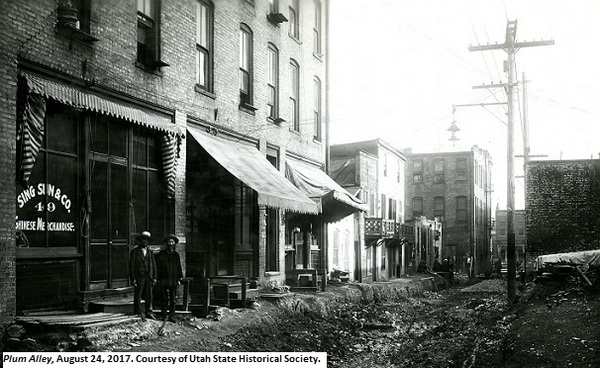Dublin Core
Title
Description
Plum Alley, a narrow lane in downtown Salt Lake City, marks what used to be the heart of a vibrant Chinatown.
Today, if you find yourself in downtown Salt Lake City walking along Second South past the Regent Street Parking Terrace, you’ll notice a modest brown plaque that marks all that remains of Plum Alley, the narrow lane that used to be the nucleus of the city’s bustling Chinatown. The alley, which ran between First and Second South and bisected the block between State and Main streets, was a thickly settled cluster of buildings—primarily restaurants, grocery stores and other shops—perched along what was once a plain dirt track.
White observers tended to see Utah’s Chinatowns, like the one anchored by Plum Alley, primarily as centers of widespread vice and illegality, and attacked the presence of gambling and opium dens in the neighborhood as evidence of a retrograde Chinese civilization. Ironically, however, people from all walks of life, including white middle-class men and women, frequented the alley’s opium and gambling joints. Even a US Marshal, Elias Parsons, landed in court on charges of renting a Plum Alley building to a group of Chinese men for the purposes of establishing an opium den.
Plum Alley, though, was much more than the terrifying vice district white reformers fretted about. It was also an important center of Chinese culture. Two of the most important fixtures of Plum Alley were the joss house and the Bing Kong Tong. The Plum Alley joss house was an informal place of worship located above a store at the intersection of Commercial and Plum. Inside, visitors could make food offerings to Chinese gods. The Bing Kong Tong, on the other hand, functioned primarily to help members find jobs and legal services, as well as to sponsor social activities. Between the joss house, the tong, and the street’s emporiums, Plum Alley was a richly textured community that deserves to be remembered.
Creator
Source
Image: Plum Alley. August 24, 1907. Two men stand outside of a Chinese merchandise store by the dirt roads and buildings of Plum Alley. Courtesy of Utah State Historical Society.
_______________
Salt Lake Tribune, January 10, 1886, April 4, 1886, March 8, 1893; Don Conley, “The Pioneer Chinese of Utah,” in The Peoples of Utah, ed. Helen Z, Papanikolas (Salt Lake City: Utah State Historical Society, 1981), 251-277; Dan Liestman, “Utah’s Chinatown: The Development and Decline of Extinct Ethnic Enclaves,” Utah Historical Quarterly 64 (Winter 1996): 70-95.

